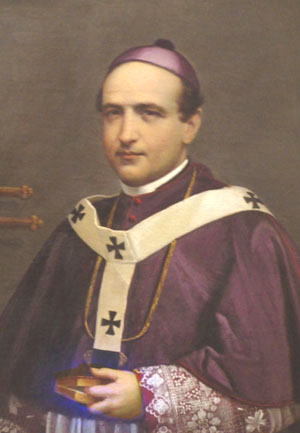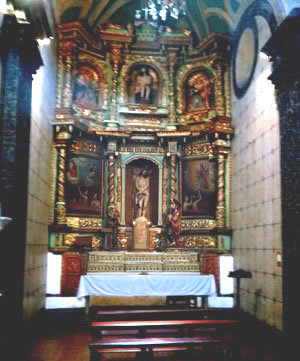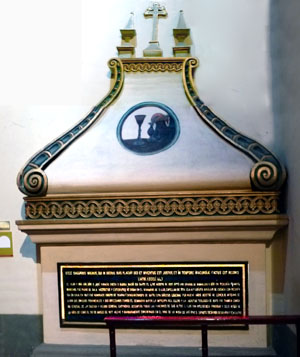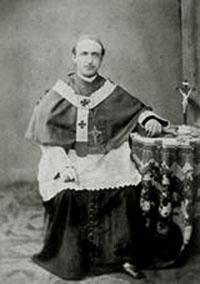 |
Our Lady of Good Success
2011 Quito Pilgrimage – Part V
“My Sons, I Am Poisoned!”
Marian T. Horvat, Ph.D.
My series on the 2011 Quito pilgrimage ends here with an account of the poisoning of Archbishop Ignacio Checa y Barba, a crime committed two years after the vicious murder of Gabriel Garcia Moreno in 1875.
After we visited the President’s tomb in the Quito Cathedral, Dr. Francisco Salazar, the scholar who discovered relics of both Garcia Moreno and Archbishop Checa, led our group to a side chapel where the remains of this Prelate are honored. Printed on his tomb is a brief biography headed by this famous text from Ecclesiastics: Ecce sacerdos magnus, qui in diebus suis, placuit Deo. Non est inventus similis illi, qui conservaret legem excelsi, which translates, "Here is a great priest, who in his days, pleased God. No one has been found to be like him in the keeping of the laws of the Most High.”

Archbishop of Quito Ignacio Checa y Barba |
Most Americans know nothing about this Prelate who courageously resisted the anti-Catholic demands of the liberal and Masonic government that had been installed shortly after Garcia Moreno’s assassination. It was his resistance that caused his death.
The poisoning
On the morning of March 30, 1877, Archbishop José Ignacio Checa y Barba was celebrating the solemn liturgy of Good Friday. After drinking the wine from the Sacred Chalice, he ordered one of the Canons assisting at the service to take away the wine because it tasted bitter and should not be used the next day for Mass.
The ceremony concluded, he exited the Cathedral by a side door and walked the short distance to the Episcopal Palace to take his lunch. He was already sweating profusely, with nausea and an unsteady step. Upon entering the Palace, he fell to the floor in acute pain, overtaken by convulsions and stomach contractions.
“I’ve been poisoned!” he exclaimed, and called for a Priest to absolve him. He told the doctor who had been summoned, “I am poisoned. I took a very bitter wine from the Chalice and I feel a terrible fire burning my entrails.”
Then he called out, “My sons, help me! Help me! I am dying!” These were his last words. His face became livid, foam came from his lips, and a few minutes later he was dead. He was 47 years old and had been Archbishop of Quito for nine years.
In the autopsy, performed shortly after his death, a large amount of strychnine was found in his body. It had been surreptitiously placed in the holy vessel containing the wine. The scheme could not have been more insidious, carried out during the Good Friday liturgy commemorating the death of Our Lord Jesus Christ.
The message to the Clergy and people was clear: The enemies of the Church had eliminated the Prelate who had become an obstacle for instigating the anti-clerical program the liberal government wanted to install in Ecuador.
Antecedent events
After the death of Garcia Moreno, moderate liberal Antonio Borrero won the presidential election of October 1875. He only governed until September 8, 1876, when the radical liberal General Ignacio Veintemilla usurped the reins of government in a military coup and proclaimed himself Supreme Chief.

The side chapel in the Cathedral; opposite the altar is the tomb, below, of Archbishop Checa
 |
Veintemilla made it clear that his government’s position toward the Church was diametrically opposed to that of Garcia Moreno. One of its first measures was to secularize education. Then came a “Letter to the Bishops” commanding them to not involve themselves in the political life of the country and to concern themselves only with spiritual works. Any priest or Bishop “who by means of sermons, letters or pastorals should try to alarm the conscience of the people and incite them to rebellion” was threatened with exile (Francisco Salazar, Encuentros, p. 64).
Archbishop Checa y Barba had maintained friendly relations with the liberals for a long time. He had been a schoolfellow of Veintemilla, and had kept a cordial relationship with him, often meeting with him in the Presidential Palace to discuss the liberal program before the coup d’etat. After that, however, he took a categorical stand of opposition against Veintemilla’s anti-clerical program. In response to Veintemilla’s decree, the Prelate wrote a Pastoral Letter condemning the usurpation of power and severely criticizing the anti-clerical measures of the new government.
The Pastoral Letter insisted on the Church’s right not only “to censure and condemn [civil] decrees,” but also “to prohibit the reading and circulating of [erroneous] writings contained in them.” Archbishop Checa affirmed he was so opposed to the revolution and that he was prepared to suffer exile rather than support it.This Pastoral Letter was issued March 10, twenty days before the poisoning.
A private meeting
On that same March 10, Archbishop Checa met with Veintemilla in the Presidential Palace at the request of the latter. Very few persons knew of this interview, Dr. Salazar told us. Part of what transpired was revealed after the Prelate’s death by Fr. Juan de Dios Campuzano, who spoke to the Prelate shortly after the meeting and heard a partial account of what had happened.
In a document addressed to the Dean of the Cathedral that only came to light much later, Fr. Campuzano wrote that General Veintemilla had insisted that Archbishop Checa retract from his position in his Pastoral Letter. To this the Prelate replied, “You can raise a gallows in the middle of the plaza for me, but I will not retract it” (Salazar, Encuentro, pp. 65-66).
Clearly the rupture could not be more complete between the two former friends.
The cover-up
Veintemilla tried to put the blame for the poisoning on Canon Manuel Andrade, who had assisted at the ceremony. Some months before Andrade had been tried for attempting to kill the artist Joaquín Pintor by poisoning him with strychnine in a fit of jealousy over a young woman. Archbishop Checa had recently reprimanded him for his scandalous behavior. Veintemilla’s niece even published a book with accusations against Canon Andrade, but every charge was soundly refuted in a response by the Dean of the Cathedral, Fr. Jose Nieto
The conservatives believed the evil deed was done by a known liberal and Freemason, Jose Vicente Solis, who also had been assisting with the Mass preparations and had placed the wine and water cruets on the altar side table. Witnesses said they saw him return quickly to the altar and furtively watch the persons assisting there, paying no attention to the Mass. Some days before he had publicly boasted, “On Good Friday, the first stone of the Masonic temple would be laid,” starting the rumor that something favorable to the liberals would happen in Quito on that date.
The prosecuting attorney for the Prelate’s family charged Solis with the crime and asked for the death penalty. The jury, composed of high officials of the Masonic government, ruled that the evidence was not strong enough to convict him; he was released along with four other liberals incriminated in the poisoning, who were also protected by the Freemasons.
No more accusations were taken into account, and the case was closed. It was widely held among Catholics, however, that the assassination of Checa, like that of Garcia Moreno, had been the work of international Freemasonry, paid for “with German money from the Kulturkampf epoch that passed through Lima” (Sonia Rueda, “Política y violencia,” p. 57)
A good final position
Dr. Salazar concluded his lecture with an eulogy of Archbishop Checa y Barba. He died a victim of religious persecution, who fell defending the principles of faith and religion. For this reason, he noted, the Archdiocese of Quito had opened the cause of beatification for him in the 1960s. His case has been paralyzed the last 40 years.

A rare photo of Archbishop Checa |
My research on this Prelate gave me a picture different from what most of the conservatives depict. Up until Veintemilla started to openly attack the Church, he seemed a moderate liberal, approving some of the political goals of the Liberal Party and striving to mitigate the forceful hand of President Garcia Moreno against his political opponents and the Freemasons. It was, in fact, against the wishes of Garcia - who proposed Msgr. Ignacio Ordóñez - that Checa y Barba was named Archbishop of Quito in 1868.
Taking a moderate position favorable to the liberal opposition, Archbishop Checa demonstrated more than once that he was not an unconditional supporter of the Garcia Moreno government, although he undoubtedly contributed in many ways to its development. One might say he practiced a ‘pragmatic politics.’ He himself tried to justify his actions saying “I am not liberal, but I am prudent. And with my prudence I have sought to do good for my Church, and if that is not what they (in Rome) think, then let them do with me what they like” (Rueda, “Política y violencia,” p. 47).
After Garcia Moreno’s assassination, however, seeing the rights of the Church threatened by the new revolutionary regime, he made the decision to oppose and fight that Liberal regime. It is my opinion that it was this last position that earned him martyrdom.
His name and admirable final position should be better known, especially in these difficult times of Holy Mother Church. He is a valiant example for those ‘moderate’ Prelates or priests of our times, inviting them to face the enemy, as he finally did, and take a categorical stand of opposition. In our days, however, opposition must be raised not just against Masonic or Communist civil governments, but also - and especially - against the Progressivism that has infiltrated even the highest layer of the Church.
Bibliography
Francisco Salazar Alvarado, Encuentro con la historia: Garcia Moreno, líder católico de Latinoamérica (Quito: Yanko Molina Editores, 2005); in English: Encounter With History: Garcia Moreno, Catholic Leader of Latin America, (Oconomowoc, WI: Our Lady of Good Success Apostolate, 2006).
Peter V. N. Henderson, Gabriel García Moreno and Conservative State Formation in the Andes, University of Texas Press, 2008.
Rodolfo Perez Pimentel, Dictionary of Ecuador, “Jose Ignatio Checa y Barba,” online
Rodolfo Perez Pimentel, El Ecuador Profundo, Vol. II, “Hijos Míos, He Sido Envenenado!” online
Sonia Fernández Rueda, “Política y violencia: Los Asesinatos del Arzobispo Checa y Barba y de Vicente Piedrahita,” Revista Ecuatoriana de Historia, No. 12, 1998

Posted April 8, 2011

Related Topics of Interest
 Impressions of Our Lady of Good Success Impressions of Our Lady of Good Success
 The Last Day of Gabriel Garcia Moreno The Last Day of Gabriel Garcia Moreno
 Discovery of Garcia Moreno's & Archbishop Checa's Remains Discovery of Garcia Moreno's & Archbishop Checa's Remains
 The Search for Garcia Moreno's Body Ends The Search for Garcia Moreno's Body Ends
 Garcia Moreno – Model of a Catholic Statesman Garcia Moreno – Model of a Catholic Statesman
 The Prophetic Mission of Mother Mariana The Prophetic Mission of Mother Mariana
 Prophecies of Fatima and Our Lady of Good Success Prophecies of Fatima and Our Lady of Good Success
 The Christ Child of Pinchincha The Christ Child of Pinchincha
 Our Lady of the Cloud in Quito Our Lady of the Cloud in Quito
 Ecuador, a Nation that Is a Reliquary Ecuador, a Nation that Is a Reliquary

Related Works of Interest
|
Our Lady Good Success | Home | Books | CDs | Search | Contact Us | Donate

© 2002- Tradition in Action, Inc. All Rights Reserved
|
 |
|